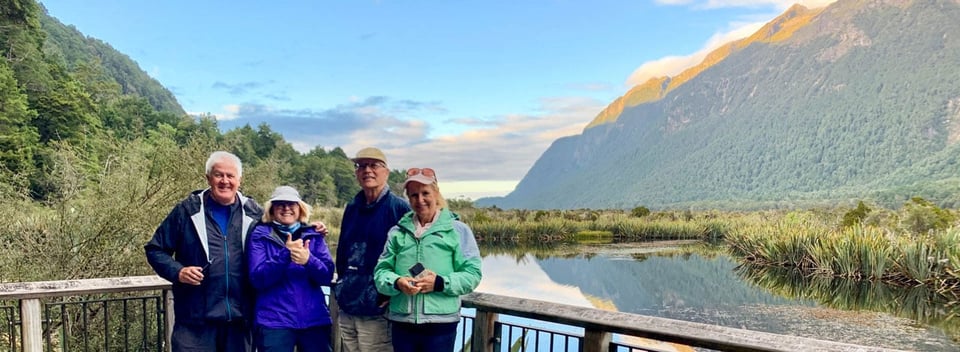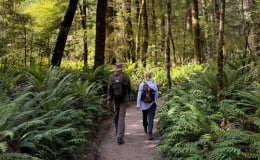
Milford Track Weather Guide for Hikers
Milford Track, dubbed the ‘finest walk in the world’ by poet Blanche Baughan, is one of New Zealand’s Great Walks, located in Fiordland National Park.
The uber-popular track takes you from Te Anau Downs to the glorious Milford Sound and often books out months in advance for Great Walks season (October to April).

Two of our awesome guests on the Milford Track during their very own Great Walk Adventure.
The track, featured in our New Zealand Great Walk Adventure and World Heritage trips, is a fantastic viewing platform into Milford Sound which is the wettest inhabited place in New Zealand, and one of the wettest places in the world. Luckily, the rain could be just the thing to make your Milford Track hiking adventure extra magical – and there’s plenty of it, with an average rainfall of about 7000mm (275in) per year!
On particularly wet days, temporary waterfalls will feed permanent waterfalls, some of which can grow to more than 1000m (3280ft) in size as they cascade down gargantuan cliff faces.

One of many incredible waterfalls on the Milford Track.
You can also expect some truly stellar sun-soaked weather in peak season which can change in an instant. As we say at New Zealand Trails, you can sometimes experience four seasons in one day!
We’ve put together a quick weather guide, to help you pick the perfect moment to embark on this truly epic tramp!
Peak season weather (October to April)
A rule of thumb on this track is always expect rain! It can come in an instant, and you’ll see by our snapshot of average rainfall in the grid below, the track still gets a healthy dose of it, even in the hottest months.
One of our tramping tips is to always put your waterproof gear at the top of your pack, so you can get it out in a flash!
Throughout summer though, average temperatures remain relatively consistent, staying mostly in the 18°C-20°C (64°F-36°F) range and cooling slightly in the shoulder months (October and April).
The hottest and most popular months are, of course, January and February - the peak of Kiwi summer, when most New Zealanders are on holiday!
Off-peak season (May to October)
The track is open all year round, transformed by crystalline white snow and rain continues to enhance those wondrous waterfalls.
With that said, especially in winter, the track should only be attempted by experienced hikers with alpine and river crossing skills.
In the off-season, the Department of Conservation (DoC) does not maintain track facilities, and bridges are usually removed, requiring trampers to have extensive knowledge and experience in river crossings. With the heavy rainfall, it’s common for streams and rivers to rise and the track floods often.
Temperatures plummet to around 1°C - 9°C ( 33.8°F - 48.2°F), there are strong winds and snow often covers parts of the track, making it tricky to navigate and prone to avalanches. If you are setting out on a wintery Milford Track adventure, be sure to get a comprehensive weather and avalanche risk report from NIWA.

Trek through the beautiful native bush of Fiordland.
What to bring for weather conditions
For the best tips on how to pack, check out our comprehensive packing guide, and for weather-specific items, see below!
The basics:
- Waterproof and windproof raincoat and overtrousers
- Hiking boots (firm, comfortable, waterproof)
- Shirt (wool or polypropylene)
- Socks (wool or polypropylene)
- Quick-dry shorts
- Under layers, top and bottom (wool or polypropylene)
- Mid-layers (wool or polar fleece)
- Sunglasses
- Sunscreen
- Hat
- Personal locator beacon
For off-season (in addition to the basics):
- Ice axe
- Crampons
- Avalanche beacon
- Avalanche probe
- Snow shovel
- Helmet
- Gas cooker (there are no cooking facilities available outside peak season)
There are not very many places in the world where you’ll look forward to rainfall, but take our word for it, Milford is one of them.
Clear days on the track will treat you to 360° views of deep valleys and mountain vistas atop McKinnon Pass while rain, which can almost always be expected, enhances the larger-than-life Sutherland and McKay Falls. Summer is a great time to take a dip in one of the many refreshing swimming holes along the track.
In the off-season, snow blankets parts of the track and decorates the mountains which tower over deep valleys. You’ll enjoy the track mostly undisturbed as low temperatures are responsible for lower numbers.
FAQ:
Why is Milford so wet?
Milford’s unique landscape and positioning amongst mountains and the Tasman Sea means it’s almost got its own micro-climate. This type of weather is called orographic rainfall, which happens when warm, moist air lifts and moves over a mountain range and as the air cools, orographic clouds form and become a source of rain, then the cycle repeats.
Is the Milford Track open year-round?
Yes! The best (although busiest) time to go is during the Great Walks season (October to late April). If you’re planning to do the track outside Great Walks season (late April to October) it’s really important you’re knowledgeable and experienced in alpine conditions and river crossings as the weather can go a little wild during this time!
If you'd like to learn more about our awesome trips here at New Zealand Trails pick up a copy of your FREE BROCHURE HERE!







